
intonsa head & thorax
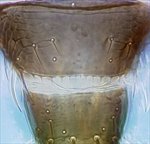
intonsa tergite VIII-IX
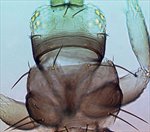
schultzei head & pronotum
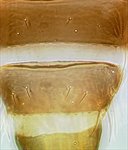
schultzei tergites VII-IX
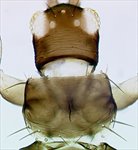
tenuicornis head & pronotum

tenuicornis meso & metanota
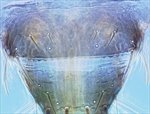
tenuicornis tergites VIII-IX

occidentalis head & thorax
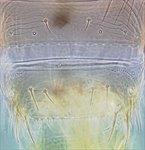
occidentalis tergites VII-VIII
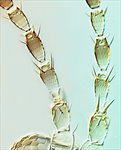
cephalica antennal segment III
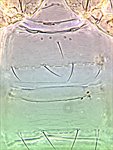
williamsi sternites I-III
Generic diagnosis
Female macropterous, sometimes wings reduced. Head usually a little wider than long; maxillary palps 3-segmented; eyes usually with 5 pigmented facets; ocellar setae I present; setae III variable in position, usually elongate. Antennae 8-segmented (rarely 7); segment I without paired dorso-apical setae, III and IV with sense-cones forked, III–VI with some microtrichia on both surfaces. Pronotum usually with two pairs of long setae at anterior margin and two pairs of long posteroangular setae; usually five pairs of posteromarginal setae, S2 setae elongate with extra pair S1 medially. Mesonotum with median pair of setae usually near posterior margin; campaniform sensilla present. Metanotum with varied sculpture; median pair of setae usually at anterior margin; campaniform sensilla present or absent. Fore wing, when fully developed, with complete setal row on first and second veins; posteromarginal fringe cilia wavy. Prosternal ferna weakly connected at middle; basantra membranous, without setae; prospinasternum broad and transverse. Mesosternum with sternopleural sutures complete; endofurca with spinula. Metasternal endofurca without spinula. Tarsi 2-segmented. Tergites without craspeda; tergite II with three lateral marginal setae; IV or V–VIII with paired ctenidia, VIII with ctenidia anterolateral to spiracles; IX with MD setae well-developed, two pairs of campaniform sensilla present or anterior pair absent; tergite X with longitudinal split complete. Sternites without craspeda or discal setae (sternite II rarely with one or two discal setae); sternite I with three microsetae near anterior margin; sternite II with two pairs of posteromarginal setae, III–VII with three pairs, all posteromarginal setae arising at posterior margin; laterotergites without discal setae.
Male tergite IX with posteroangular setae often stout; sternites III–VII each with a pore plate.
Biological data
Members of this genus are associated with a very large number of different plant species, and some are highly polyphagous. Although usually associated with flowers, some species breed both in flowers and on young leaves. A few species are important horticultural pests, and these are also vectors of the crop-damaging tospovirus diseases.
Distribution data
Most species of this genus are from the New World, particularly from the Neotropics (Nakahara, 1997), but several have become widespread around the world.
Nomenclatural data
Frankliniella Karny, 1910: 46. Type species Thrips intonsa Trybom 1895, by subsequent designation of Hood, 1914: 37.
With nearly 240 species, this is one of the largest genera of Thysanoptera (ThripsWiki, 2020). Most of the species are from the New World, but only seven are now recognised from China (Wang et al., 2019b).
cephalica (Crawford DL, 1910: 135). (Euthrips)
intonsa (Trybom, 1895: 182). (Thrips)
lilivora Kurosawa, 1937: 269.
occidentalis (Pergande, 1895: 392). (Euthrips)
schultzei (Trybom, 1910: 151). (Physopus)
tenuicornis (Uzel, 1895: 99). (Physopus)
williamsi Hood, 1915: 19.
Relationship data
Thripidae sub-family Thripinae: this is a diverse group involving more than 230 genera. This is one of nine genera recognised in the Frankliniella genus-group (Mound, 2002). All of the species have ocellar setae pair I present in front of the first ocellus, paired ctenidia are present on the abdominal tergites, and on tergite VIII the ctenidia are antero-lateral to the spiracles. The only other members of this genus-group recorded from China are Firmothrips, Parabaliothrips and Yaobinthrips (Wang et al., 2019a).
References
Mirab-balou M, Tong XL & Chen XX (2014) Re-description of aquatic grass-inhabiting thrips, Frankliniella zizaniophila, with remarks on its systematic position within the genus Frankliniella (Thysanoptera). Journal of Insect Science 14 (154): 1–7.
Mound LA (2002) The Thrips and Frankliniella genus groups: the phylogenetic significance of ctenidia. Pp. 379–386 in Marullo R & Mound LA [eds] Thrips and Tospoviruses: Proceedings of the 7th International Symposium on Thysanoptera. Australian National Insect Collection, Canberra.
Nakahara S (1997) Annotated list of the Frankliniella species of the world (Thysanoptera: Thripidae). Contributions on Entomology, International 2: 355–389.
ThripsWiki (2020) ThripsWiki - providing information on the World's thrips. <http://thrips.info/wiki/Main_Page>
Wang ZH, Mound LA & Tong XL (2019a) Phylogenetic relationships within the Frankliniella genus-group based on morphology, with a revision of Iridothrips (Thysanoptera, Thripidae). Zootaxa 4651 (1): 141–154.
Wang ZH, Mound LA & Tong XL (2019b) Frankliniella species from China, with nomenclatural changes and illustrated key (Thysanoptera, Thripidae). ZooKeys 873: 43–53.